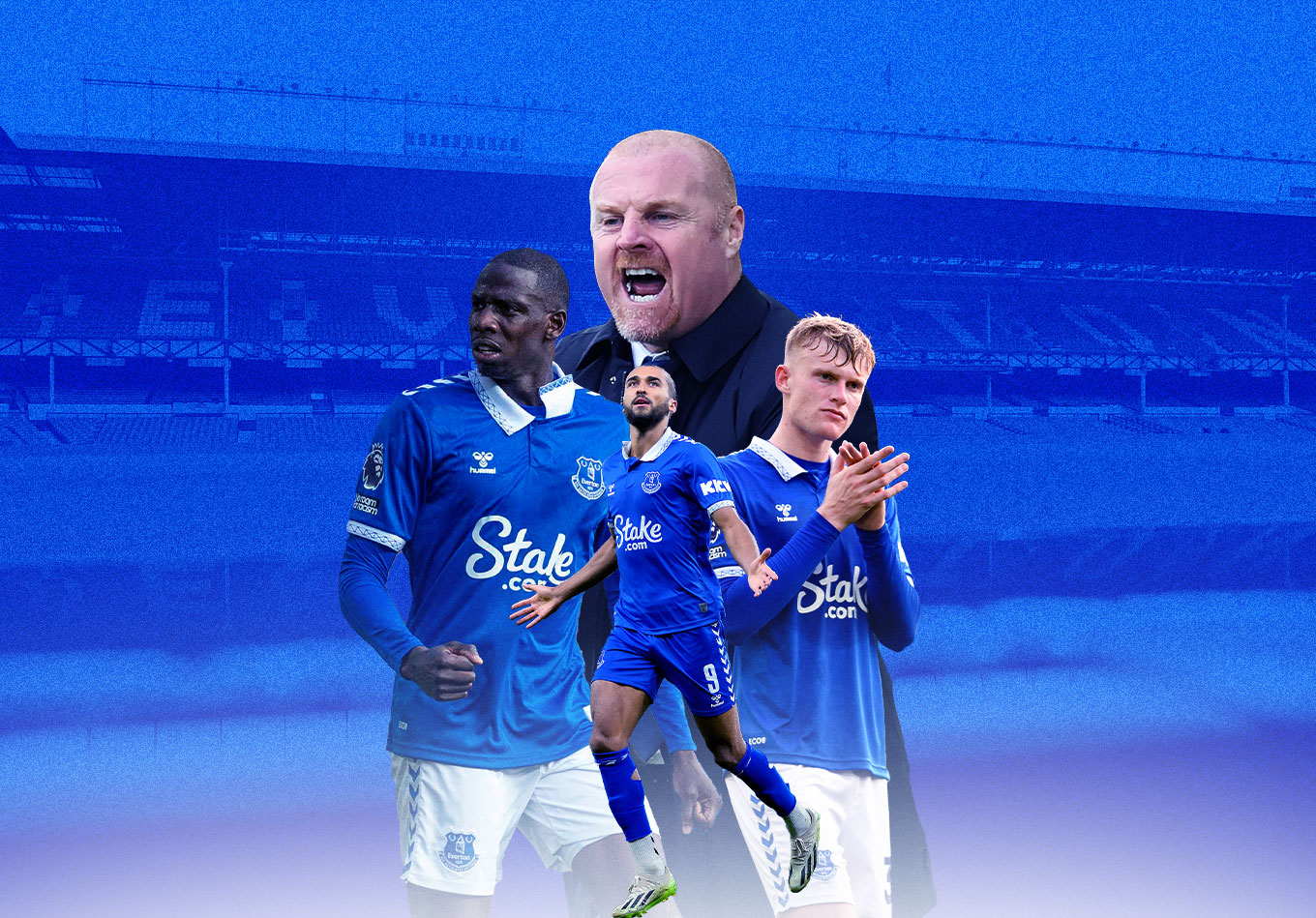After a dismal start to the season, Everton’s luck has started to turn. But with Liverpool next up in the Merseyside derby, Sean Dyche still has plenty of work to do.
Everton boss Sean Dyche may not be one of the Premier League managers that immediately springs to mind when thinking about those who might use stats to back up hypotheses. Yet, over the early part of the 2023-24 season, he’s certainly not shied away from pointing to the underlying numbers behind Everton’s performances.
That said, the underlying numbers are perhaps all he’s had to point to for much of the past two months.
Everton started the season without a win in five Premier League games, losing four of those as the blues from the last two seasons rolled into a third campaign. Three of those games came at home, with the opening two – against Fulham and Wolves respectively – put down by many Evertonians as fixtures that their team must be taking points from if they’re to avoid a third consecutive relegation battle. Their only positive result came away at Sheffield United, where they drew 2-2 but many might have expected them to win. This remains the Blades’ only point of the season.
Before the much-needed win over Bournemouth – Everton’s first victory at Goodison Park this season – prior to the international break, Dyche pointed to his side’s expected goals (xG) output, saying: “The xG is very high, it is the highest it has been for eight years. It’s a pretty attacking format we use. We played well, we dominated large parts, but I’m well aware, we need to win football matches, that’s got to change.”
In fairness, Dyche wasn’t wrong.
Prior to the Bournemouth game, Everton had averaged 1.77 xG per league match this season. A small sample size, granted, but that is 0.38 higher than the 1.36 average xG Everton mustered per match in 2019-20, which is the high mark from the previous eight years.
If we include the Bournemouth match, in which Everton accumulated 2.49 xG and won 3-0, the Toffees’ average leaps up to 1.86. They are fourth in the Premier League – behind Tottenham, Brighton and Newcastle United – for non-penalty xG (14.92).
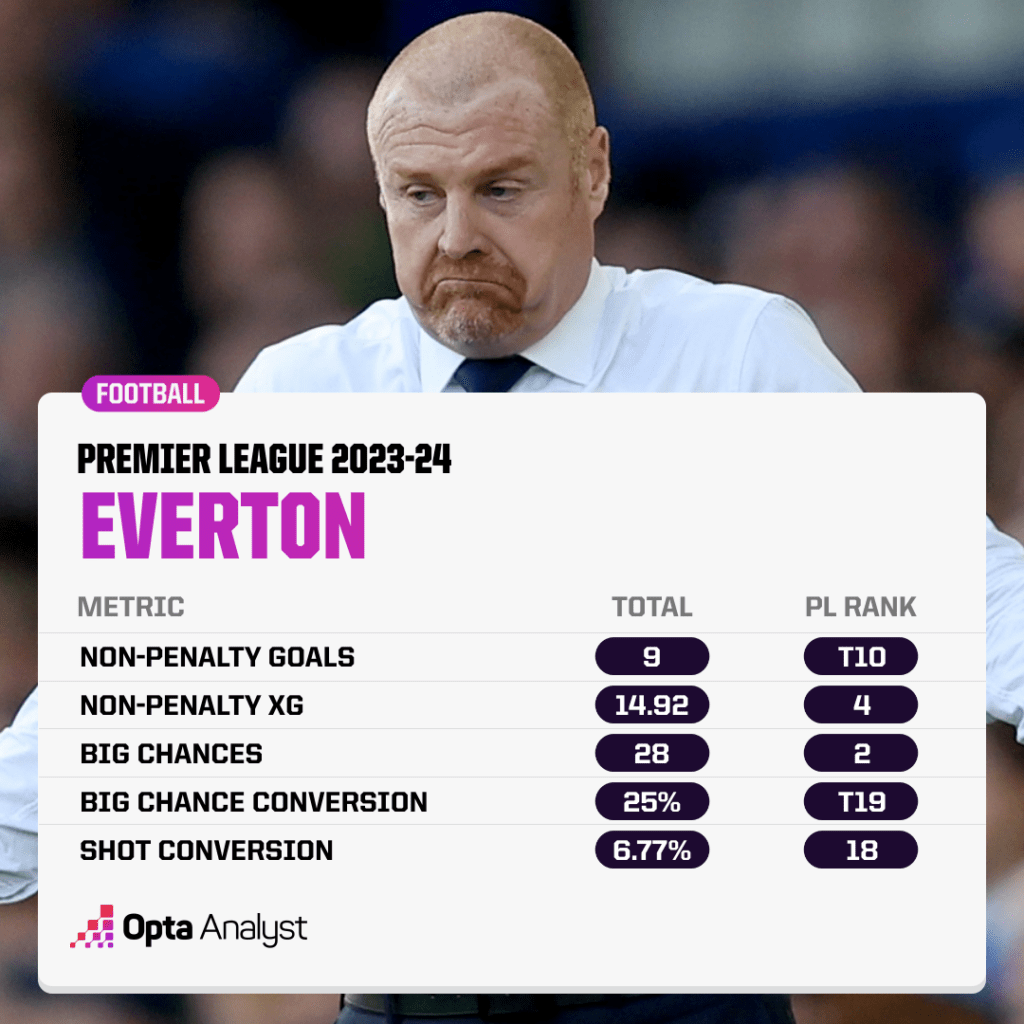
Now, we have to add some context to those numbers.
Everton have gone up against European-calibre opposition twice in the league this season. They failed to lay a glove on Arsenal and were soundly beaten 4-0 by Aston Villa (though they did subsequently defeat Unai Emery’s side 2-1 in the EFL Cup at the end of September).
Despite that, using the Opta Power Rankings, we can actually determine that Everton have had the easiest start of any Premier League side. The average rating of the sides they have faced is 85.15. Based on this metric, it is Wolves who have had the toughest start in the competition sdo far (89.48).
They had to wait until 23 September for their first top-flight victory of the campaign, and it came away at Brentford. Since then, Everton have won a further two matches in all competitions, but those victories sandwiched a desperately disappointing home defeat to Luton Town.
Like in the Wolves and Fulham games in August, both of which Everton lost 1-0, the Luton defeat saw the Toffees record a much higher xG (2.90 to 0.89 in this case) and have 23 shots, but some surprisingly slack defending from set-pieces saw Dyche’s team suffer another costly defeat.
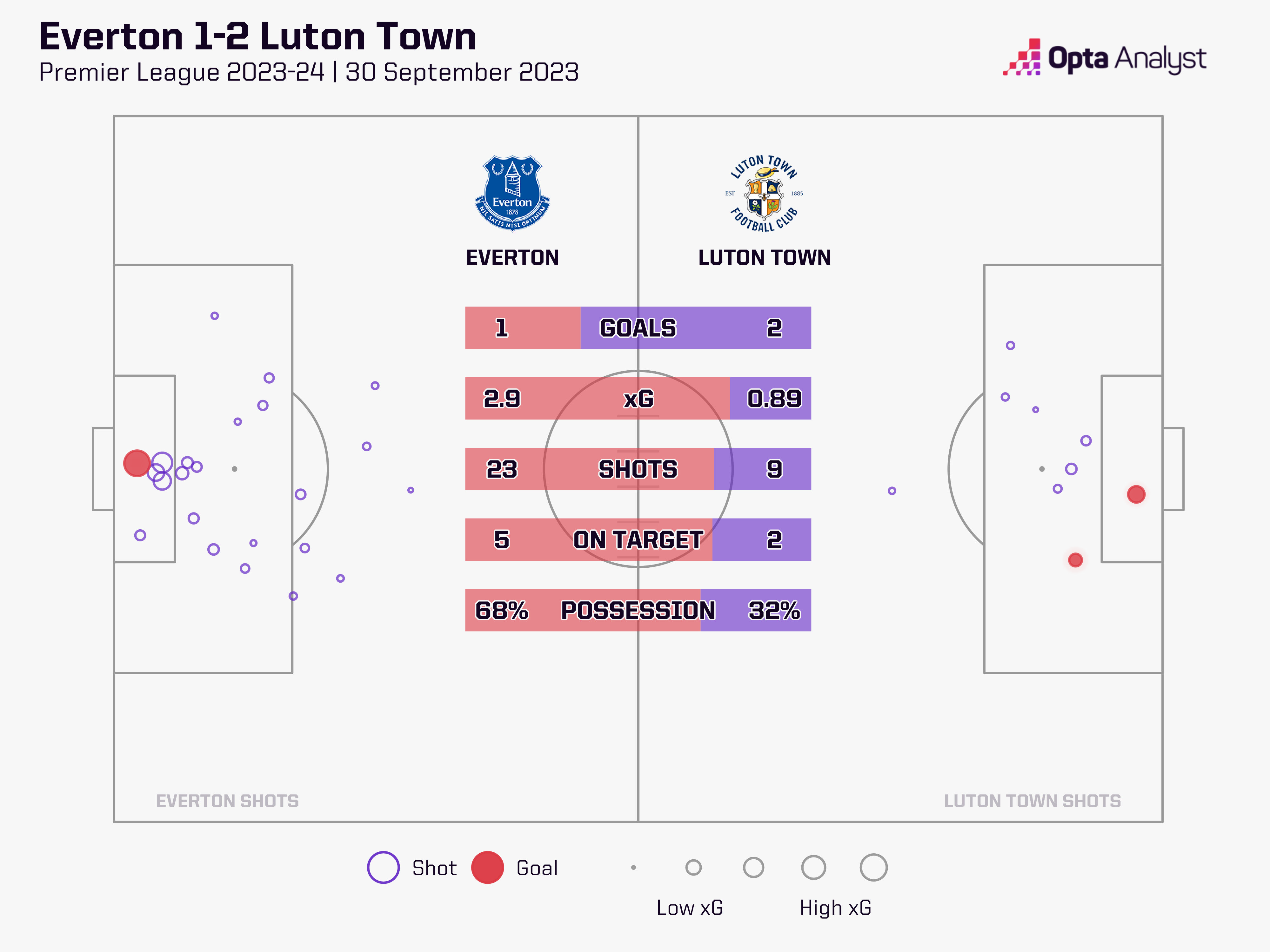
In seasons gone by, losing four straight home games – and seven of the last eight when tracking back to last term – might have seen Farhad Moshiri pull the trigger on Dyche; after all, only five teams in top-flight history have ever lost their first five home matches of a season – Manchester United in 1930-31, Portsmouth in 2009-10, Bolton Wanderers in 2011-12, Newcastle United in 2018-19 and, after their defeat to Chelsea, Burnley this term.
Moshiri, though, has all but checked out, having agreed to sell his 94.1% stake in the club to Miami-based private investment firm 777 Partners. While that transaction goes through the Premier League’s approval process, it seems unlikely any swift decisions will be made on Dyche’s future, and perhaps that will buy him more time.
Make no mistake, though, Everton needed a positive result on top of the promising underlying metrics against Bournemouth, a team against whom Everton had won five of their previous six home Premier League matches. That run includes the game when Abdoulaye Doucouré lashed in a spectacular winner on the final day of last season to keep the Merseysiders in the top flight.
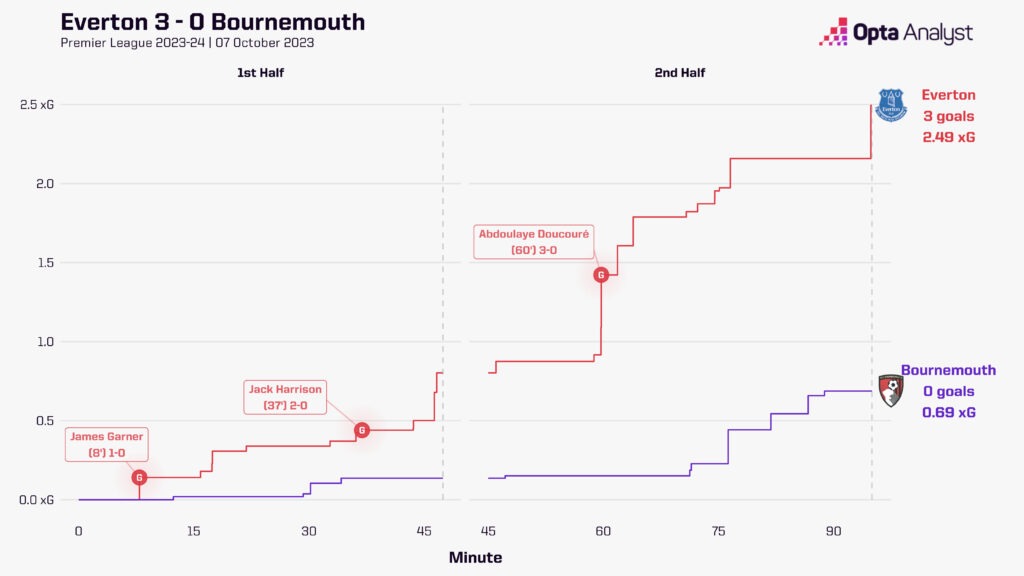
Perhaps Everton ‘progressed to the mean’ in that win over Bournemouth, where their real output finally matched what was expected based on the quality and quantity of opportunities they have created. That said, Dyche still has work to do ahead of a tough run, starting with the Merseyside derby at Anfield on Saturday. After that game, Everton face West Ham, Brighton and Crystal Palace before the next international break, not to mention an EFL Cup tie with Dyche’s old team Burnley.
Relegation Candidates or European Contenders?
Everton are underperforming.
They might have been expected to score 15 goals, but they have managed just nine. Only league leaders Tottenham (153) have had more shots than Everton (133), but the Toffees’ conversion rate is a meagre 6.77%, the third worst in the top tier.
Only Newcastle (31) have created more big chances (defined by Opta as an opportunity from which a player would be reasonably expected to score) than Everton (28), yet Everton have converted just seven of them. Everton’s big chance conversion rate of 25% is tied with Burnley and Bournemouth as the second-poorest in the division.
It paints a pretty clear picture: Everton have created plenty, but have failed to put those opportunities away with any consistency.
Once again we must take the standard of the opposition into consideration. For example, against Arsenal at Goodison Park on September 17, Everton had only eight shots and mustered just 0.34 xG. It is much easier to create opportunities against the likes of Fulham, Wolves, Luton and Bournemouth than it is against teams competing at the top end of the table (go figure?).
Also, many of their opportunities have fallen to players whose primary job is to be something other than a goalscorer, suggesting Everton aren’t creating good chances for the right players. More players have missed a big chance for Everton this season (12) than any other team in the Premier League.
So, while keeping these considerations in mind, let’s take a look at how much have Everton underperformed by.
According to Opta’s expected points model, 16th-placed Everton – who have taken seven points from the 24 on offer – should actually find themselves as high as fifth, on at least 14 points. Not only would that have them as possible European contenders, but it would see them sit a place above Liverpool (who occupy fourth spot in reality) heading into the derby.
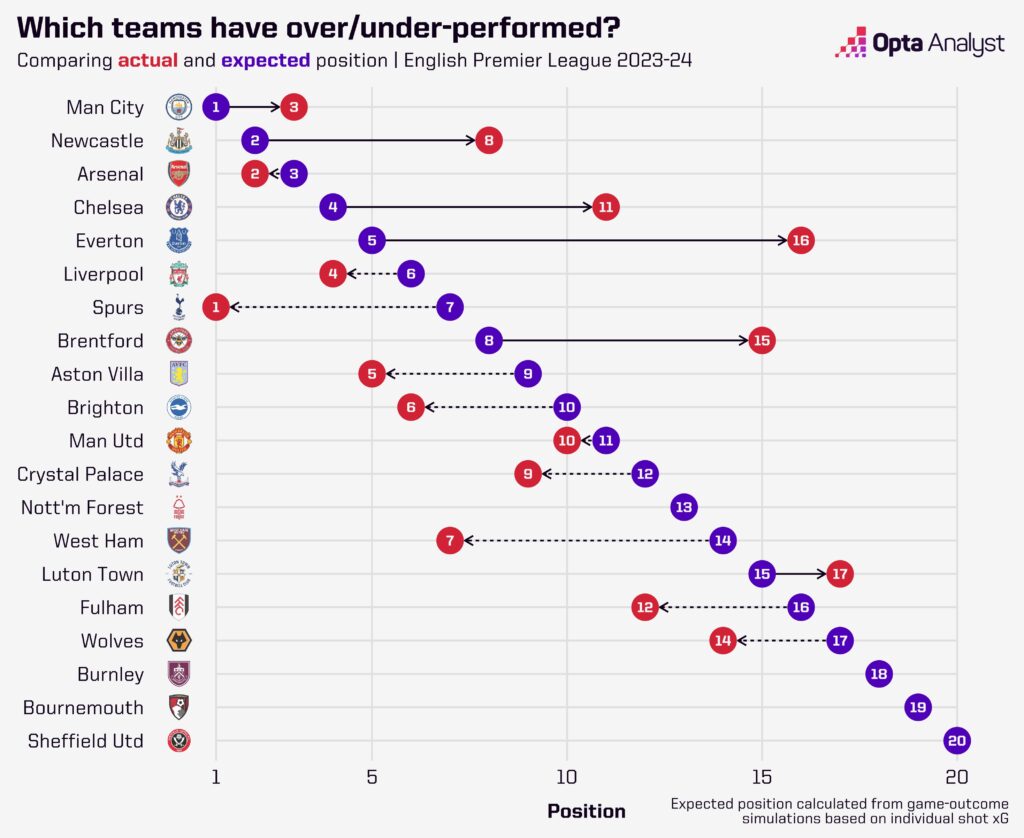
At the other end, despite conceding some sloppy goals, Everton are sixth best for expected goals against (xGA), with 10.41. They are undoubtedly the league’s biggest underperformers, sitting a whopping 11 places lower than the data suggests they should be, while their points difference of -7.64 is also the greatest in the top flight.
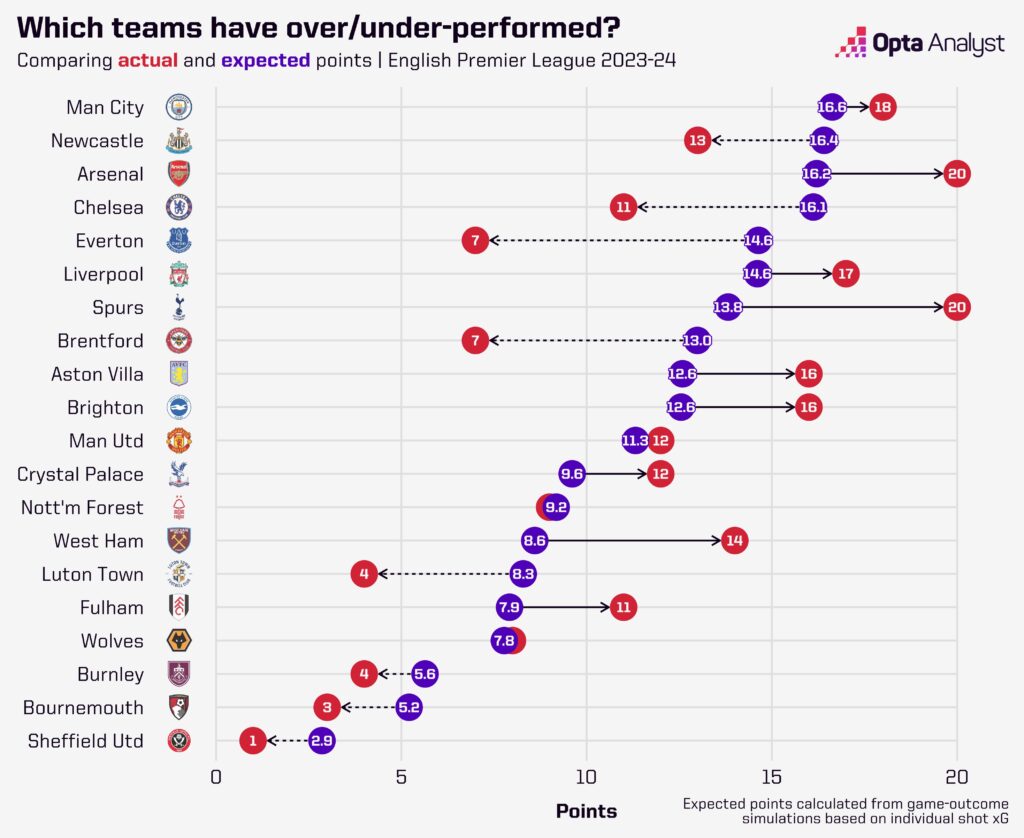
By contrast, West Ham – who Everton face on 29 October – are the competition’s biggest overperformers when it comes to expected points, with David Moyes’ side sitting in seventh when the metrics suggest they should be 14th.
How Are Everton Creating Chances?
High pressure, set-pieces and crosses are Everton’s main routes to goal.
Only Luton (196) have attempted more crosses than Dyche’s team (177), while only the Hatters (131) and Chelsea (122) have played in more crosses from open play than Everton (120) – just 20 of those 120 have been successful, though.
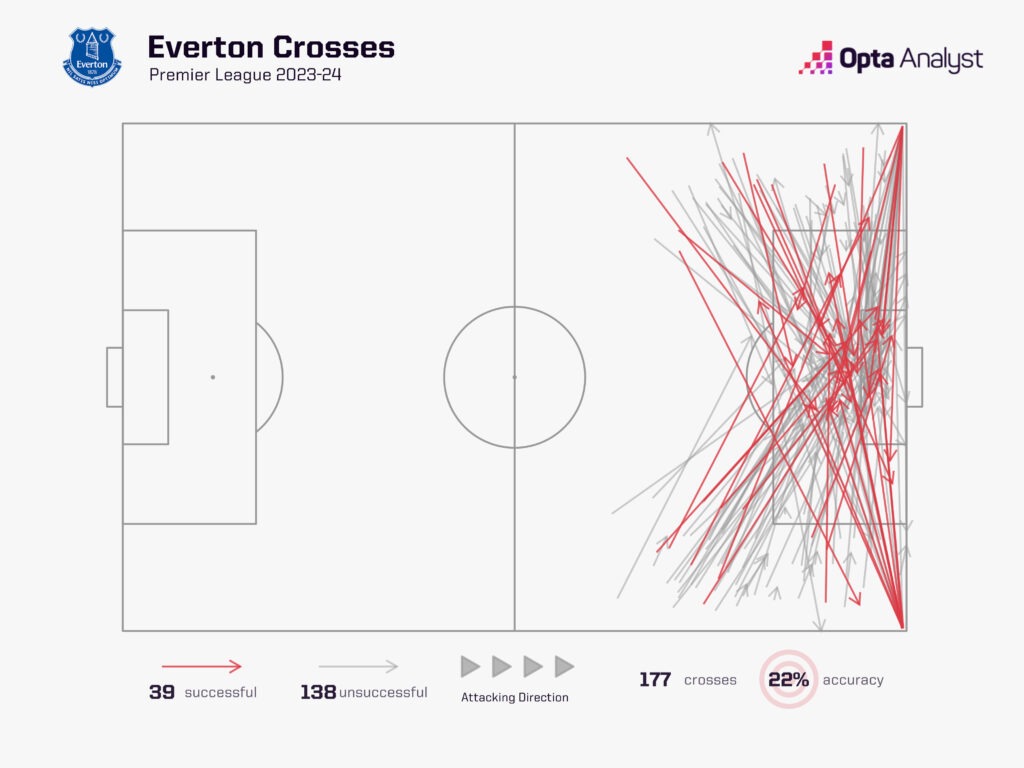
Meanwhile, Brentford are the only side to have accumulated a higher xG (4.95 to 4.33) from set-pieces than Everton this season.
Everton have found joy when pressing in their opponents’ defensive third, with their tally of 80 high turnovers ranking fifth in the league, behind Luton, Chelsea, Tottenham and Manchester United. Their haul of 14 shot-ending turnovers is joint-third alongside United and Luton, with Spurs (18) and Brighton (19) ahead. Only one of these turnovers has resulted in a goal, however, again showing Everton’s profligacy when it comes to converting good opportunities.
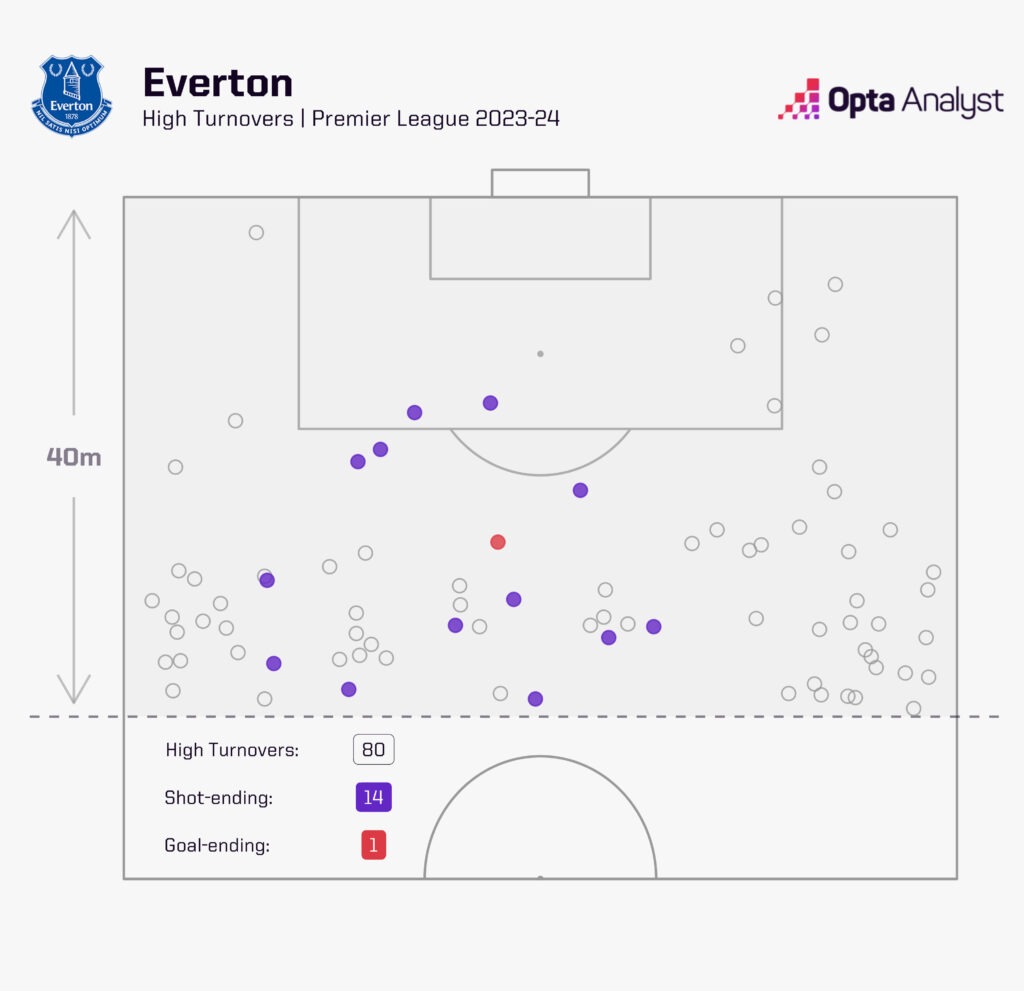
Unsurprisingly, Everton rank 17th for moves that involve 10 or more passes, with just 46. Dyche is not overly concerned with patient build-up play, and while that is not necessarily a bad thing, the defeat to Luton in September showed a worrying lack of nous from his players when it came to breaking down a low block. It is telling that Everton ended the game with 67.6% of the ball – their average possession for the season stands at 45.4%.
Everton’s high press is further evidenced by the average starting distance of their open-play sequences being 43.6 metres from their own goal. That is level with Chelsea, and higher than Arsenal, Brighton, Spurs and Bournemouth, with only Newcastle, Manchester City and Man Utd starting their attacks closer to the opponent’s goal on average. It’s not bad company to be keeping.
They do pick and choose their moments, mind. They are not exactly pressing monsters. Dyche wants to keep a solid structure where possible; they rank 11th for passes allowed per defensive action (PPDA), at 12.6. That is 3.6 more than league leaders Tottenham but compares similarly with Man City (12.1) and Man Utd (12.3).
Everton are also eighth in the league for field tilt – a metric that measures possession in the final third of the pitch compared to how much possession you allow your opponents in your own third. At 53%, they rank higher than Liverpool and Aston Villa, and behind only clubs that are certain to be competing for European places this season.
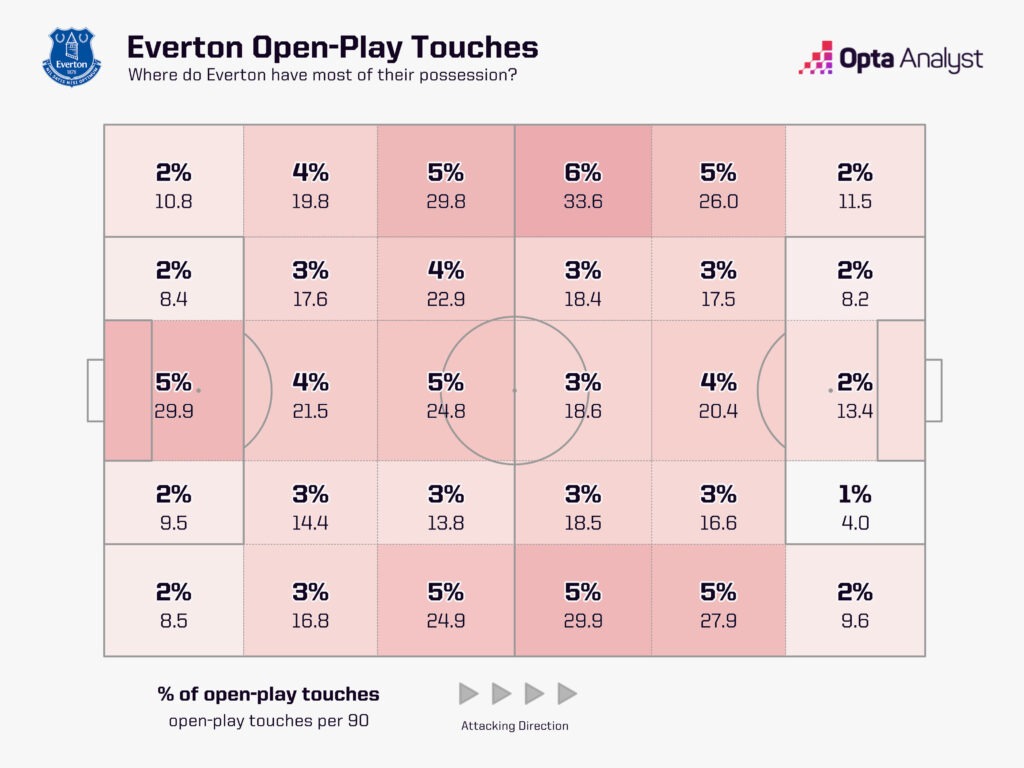
The return to fitness of Dominic Calvert-Lewin – and the £21.5 million signing of Beto from Udinese – has been a huge help, there’s no doubt about that.
Whether it’s Calvert-Lewin, who scored three goals in as many games last month, or Beto, Everton now have a focal point to hit up top, something they lacked for large parts of last season when Anthony Gordon, Neal Maupay or Demarai Gray — who have all left the club over the course of the last two transfer windows — would often lead the line.
While he has only played 262 minutes, Calvert-Lewin is averaging the best non-penalty xG per 90 of his Everton career (0.86). He is also having 7.2 touches in the opposition box per 90, way above his previous high of 5.0.
When compared to forwards in Europe’s top five leagues over the past 15 years, Calvert-Lewin ranks in the 93rd percentile for goals, 91st for shots, 94th for touches in the opponent’s penalty area and 98th for aerials won. That is up from the 10th, 42nd, 64th and 95th percentiles for those respective categories last term.
A fully fit and firing Calvert-Lewin is a force to be reckoned with, and Dyche must be credited for the work he has done in getting the 26-year-old back to fitness.
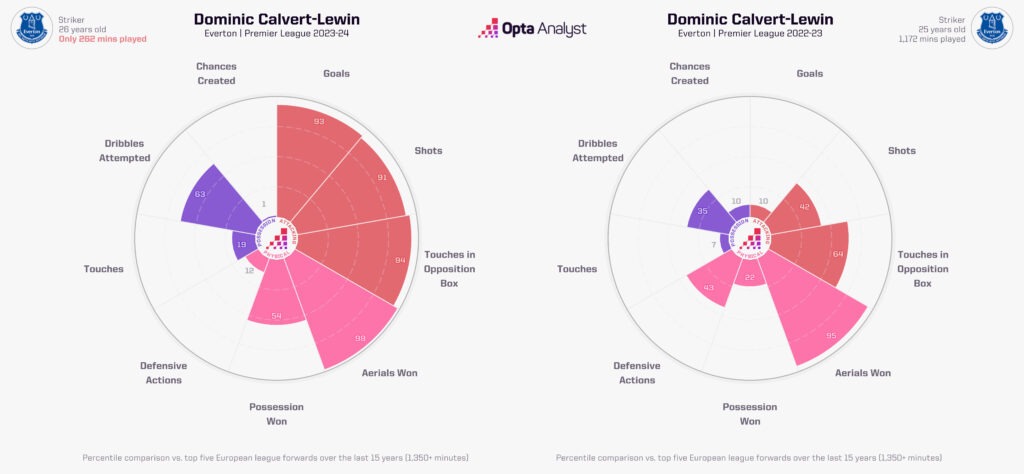
With Dwight McNeil having hit form since Dyche replaced Frank Lampard back in January, and Jack Harrison, Arnaut Danjuma and the industrious Doucouré providing versatile forward options, Everton’s attack looks in a much better place.
Again, all of the metrics are pointing in the right direction, so…
Now What?
The next run of fixtures will show just how much of the positive data is actually down to Everton, or if it has more to do with the lower quality of the teams they’ve faced.
In theory, given how Dyche prefers to play, Everton might get joy against teams who would be expected to have more of the ball in Liverpool and Brighton, who have averaged 52.8% and 60.3% possession respectively this season. West Ham, meanwhile, have only averaged 37.4%, but given the Hammers will be at home in their game against Everton on 29 October, the onus is likely to be on them to set the tempo. Again, this could suit Everton perfectly.
Only Villa (13) have had more shots from fast breaks than Everton (11), further evidence of their proficiency at springing counter-attacks, but defensively Dyche’s side will have to be on it.
Everton’s xG against is the sixth best in the Premier League at 10.41, but they have conceded 12 goals. While that’s not a huge differential, the number alone does not take into account the teams they have played. Everton may be fortunate if that figure does not rise sharply when they face the attacking talents of Liverpool and Brighton, while in James Ward-Prowse, West Ham have a player capable of delivering a wicked dead-ball delivery.
While Everton rank highly for xG from attacking set-pieces, their xG against (2.7) is not so favourable; there were some worrying signs against Luton and that trend followed against Bournemouth, with Vitaliy Mykolenko often left isolated at the back post when defending free-kicks. Everton are level with Brentford, Bournemouth, Nottingham Forest and Sheffield United for goals conceded from set-pieces (four).
Ultimately, Everton’s underperformance so far means they have work to do to get back on the right track. Pointing to the expected points table is fine, but it is the real-life standings that count, and Dyche will be judged on real-life results.
Everton’s next four league fixtures come against teams that are all way above them in the Opta Power Rankings. While Everton are down in 68th, Liverpool are third; Brighton 20th; West Ham 24th and Crystal Palace 38th.
It’s a tough series of matches and Everton are unlikely to be favourites heading into any of them. Dyche must hope that suits his charges down to the ground, because as bright as the numbers look, the results must follow soon.
Enjoy this? Subscribe to our new football newsletter to receive exclusive weekly content. You should also follow our social accounts over on X, Instagram, TikTok and Facebook.
